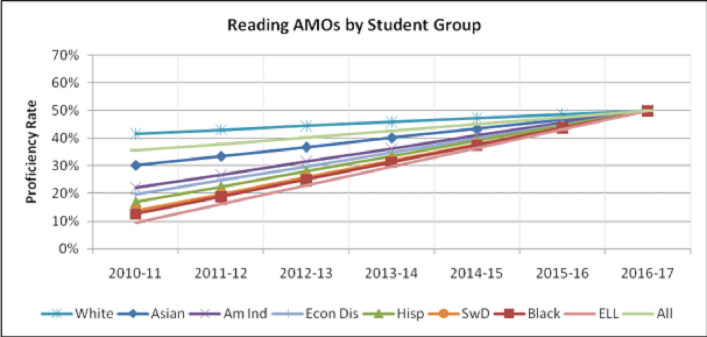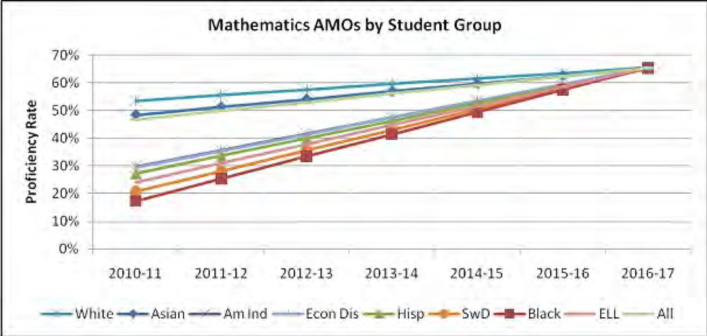What Is the Annual Measurable Objective Amo in Language Arts Literacy Lal
Background
Under the sometime federal educational activity law—No Child Left Behind—the US Department of Education required states to establish "aggressive but achievable" AMOs in reading and mathematics proficiency likewise as in graduation and attendance rates, and to publicly report performance on the AMOs.
The following were the AMOs used in Wisconsin until the federal education constabulary was reauthorized equally the Every Child Succeeds Human activity (ESSA) in December 2015. ESSA ended the use of AMOs in school accountability systems. Withal, for those interested in accountability history and those who want to reference the former AMO targets, please refer to the charts beneath.
What were the AMOs?
The US Department of Education (USED) required states to establish aggressive but achievable AMOs in reading and mathematics proficiency and in graduation and omnipresence rates, and to publicly written report functioning on the AMOs. Using 2011-12 information, AMOs were fix to motility all schools in the state, within 6 years, to the level of those schools that were performing at the 90th percentile in 2011-12. That is, past 2016-17, the expectation was for all schools to take all pupil groups accomplish almost 50% reading proficiency and 65% mathematics proficiency.


These AMOs reflected the higher college and career prepare cutting scores established in Wisconsin'southward waiver asking for ESEA Flexibility. The AMOs expected an increase of 1% or more in proficiency rates annually. This bodacious that the top-performing subgroups would continue to make progress. The six-yr targets of 49.nine% proficiency in reading and 65.3% proficiency in mathematics reflected dramatic increases in performance for most subgroups.
| Annual Increment | Wisconsin Reading Proficiency AMOs | |||||||
| 2010-xi | 2011-12 | 2012-13 | 2013-14 | 2014-xv | 2015-16 | 2016-17 | ||
| All Students | 2.four% | 35.5% | 37.nine% | 40.3% | 42.7% | 45.1% | 47.five% | 49.ix% |
| American Indian | 4.7% | 22.1% | 26.8% | 31.5% | 36.ii% | 40.nine% | 45.half dozen% | 50.3% |
| Asian or Pacific Islander | 3.3% | thirty.2% | 33.5% | 36.8% | 40.one% | 43.four% | 46.7% | 50.0% |
| Black not Hispanic | vi.two% | 12.six% | 18.viii% | 25.0% | 31.2% | 37.4% | 43.6% | 49.8% |
| Hispanic | 5.5% | 17.0% | 22.five% | 28.0% | 33.5% | 39.0% | 44.5% | 50.0% |
| White not Hispanic | 1.4% | 41.half-dozen% | 43.0% | 44.4% | 45.8% | 47.2% | 48.half dozen% | 50.0% |
| Students with Disabilities | half dozen.0% | 13.8% | nineteen.viii% | 25.8% | 31.8% | 37.eight% | 43.8% | 49.8% |
| Economically Disadvantaged | v.0% | 19.8% | 24.8% | 29.eight% | 34.8% | 39.8% | 44.eight% | 49.8% |
| English Learners | 6.7% | 9.vi% | 16.3% | 23.0% | 29.7% | 36.four% | 43.1% | 49.8% |
| Annual Increment | Wisconsin Mathematics Proficiency AMOs | |||||||
| 2010-11 | 2011-12 | 2012-13 | 2013-xiv | 2014-fifteen | 2015-sixteen | 2016-17 | ||
| All Students | three.1% | 46.seven% | 49.viii% | 52.9% | 56.0% | 59.1% | 62.2% | 65.three% |
| American Indian | 5.nine% | 29.vii% | 35.half-dozen% | 41.5% | 47.4% | 53.three% | 59.two% | 65.i% |
| Asian or Pacific Islander | 2.eight% | 48.4% | 51.2% | 54.0% | 56.8% | 59.6% | 62.4% | 65.2% |
| Black non Hispanic | 8.0% | 17.4% | 25.4% | 33.four% | 41.iv% | 49.4% | 57.4% | 65.iv% |
| Hispanic | six.3% | 27.iii% | 33.6% | 39.nine% | 46.ii% | 52.5% | 58.8% | 65.1% |
| White not Hispanic | 2.0% | 53.5% | 55.5% | 57.5% | 59.v% | 61.5% | 63.5% | 65.5% |
| Students with Disabilities | vii.four% | twenty.8% | 28.2% | 35.6% | 43.0% | fifty.4% | 57.8% | 65.2% |
| Economically Disadvantaged | 6.0% | 29.iv% | 35.iv% | 41.4% | 47.4% | 53.4% | 59.4% | 65.4% |
| English language Language Learners | 6.9% | 24.0% | 30.ix% | 37.viii% | 44.7% | 51.vi% | 58.5% | 65.4% |
How were AMOs measured?
A group's performance compared to its AMO was measured by the higher of (i) the proficiency rate in the current year; or (2) the average proficiency rate in the current year and the prior year. A cell size of twenty and a 95 percent confidence interval were applied to determine whether or not an AMO was met.
Wisconsin used the graduation charge per unit goal of 85 percent. Carve up graduation rate improvement targets are used for the four- and six-twelvemonth rates. A school met the graduation charge per unit AMO for graduation if (i) the graduation rate for the most contempo year, or for the most contempo two years combined, met the 85 percentage goal; or (2) the improvement in graduation rate met the applicable target.
DPI would first evaluate whether a schoolhouse met the goal or target for the four-year charge per unit. If it did not, the school would be evaluated using the 6-year rate. In 2011-12, the first year of this accountability system, a five-year rate was used in identify of the six-twelvemonth charge per unit for the initial year only considering Wisconsin did non take enough information to run a six-yr rate until 2012-13.
The graduation targets for AMO determinations kickoff with those based on 2011-12 assessment results are:
| Graduation Rate | 4-Year Graduation Rate Improvement Target | Half-dozen-Yr Graduation Rate Improvement Target |
| 60% to 85% | two percentage points | five pct points |
| Less than sixty% | 5 percent points | five percentage points |
For a school, a grouping'southward performance compared to its AMO was measured by the higher of the four- or six-yr accomplice graduation rates for that group. (As with other graduation components of this organization, for the first year a five-year cohort rate was used in identify of the half dozen-yr rate.) A cell size of xx and a 95 pct conviction interval was applied to determination of whether or not an AMO was missed.
An attendance charge per unit AMO was applied when the graduation rate AMO was non applicable. A school met the attendance rate AMO if (1) the attendance rate was 85.0% or above in the virtually recent year or (two) in that location was a 0.ane% gain in attendance charge per unit. The attendance charge per unit AMO was practical to the all students group but. A prison cell size of twenty was applied.
How were AMOs reported?
USED required states to plant ambitious but achievable AMOs in reading, mathematics, and graduation and to publicly report performance on each. AMO information were reported publicly on school report cards offset with the 2011-12 schoolhouse year. AMOs were function of Wisconsin's accountability system, just they were not used to summate the accountability scores that determine ratings and support. In other words, AMOs were not factored into the accountability index; they existed outside the accountability alphabetize but were reported alongside it.
How were AMOs used by schools?
Since schools received a school written report card and the AMOs were included in the schoolhouse report carte du jour data, schools could readily guess progress with their students and specific educatee groups using school report card data. Schools could pinpoint how much progress their students and each pupil group needed to brand by 2016-17, potentially establishing multi-twelvemonth improvement plans to use as a focal point. Specifically, AMOs were used as office of the exit criteria for Championship I Focus Schools equally well equally accountability for English language Language Learners under ESEA Title Three.
For those Title I schools that were identified every bit Title I Priority or Title I Focus schools, AMOs were used as part of the exit criteria from those identifications (a four-year cohort). Equally such, these schools would take needed to pay item attention to the progress of pupil groups each year of the cohort.
AMOs were also used equally part of the accountability for English Language Learners under ESEA Title III so schools could track the progress of their English language learner population.
Source: https://dpi.wi.gov/accountability/historical/amo